Bob Moler's Hale-Bopp Observation Diary
(Apr-May '97)
Final update and corrections Oct, 7, 1997
Here I wrote down my impressions of Comet Hale-Bopp both
subjective and objective, in the hopes of encouraging others to
get out to find and view this wonderful interplanetary visitor.
Go to February and
March '97 observations

- May 8, 1997
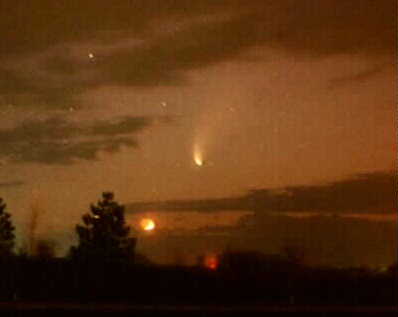 This is my last observation of
the comet. The comet appears is a big break in
the clouds in the twilight. It is a beautiful
sight with the moon and the clouds. The exposure
was about 40 seconds on ISO 400 SFW film.
This is my last observation of
the comet. The comet appears is a big break in
the clouds in the twilight. It is a beautiful
sight with the moon and the clouds. The exposure
was about 40 seconds on ISO 400 SFW film.
- May 6, 1997
- The comet still visible above the horizon as
twilight ends. I'm back in the shrubbery to get
photographs. The dust tail seems about 7 degrees
long, and its highly curved near the head. The
comet still appeares about as bright as the star
Aldebaran as both appeared at nearly the same
altitude. Aldebaran appeared a bit lower.
- May 4, 1997
- The comet is really getting low by the time it
gets dark now. I moved my photographic equipment
to my shrubbery line to get a lower horizon.
However that meant that I had to interrupt the
time photographs for passing cars. The tail looks
shorter now, perhaps 5 degrees. I wasn't sure
there was an ion tail. The comet appeared about
as bright as the star Aldebaran as the both of
them appeared at the same altitude. That means
the comet is still first magnitude.
- May 1, 1997
- Clear skies have been few and far between. I am
out to take a few photographs of the setting
comet. The dust tail appears surprisingly long,
nearly 10 degrees, and appears quite bent near
the head. I cannot detect the ion tail at all.
The zodiacal light in the west appears dimmer and
less impressive that it did early last month, as
does the comet.
- April 25, 1997
- The public viewing night at the Rogers
Observatory saw clear skies. In the Celestron 14
inch telescope, only one or two of the shells
could be seen. Being out at the observatory
entertaining visitors, I couldn't take any
photographs. Jerry Dobek did take a photo or two
through the 8 inch Schmidt camera.
- April 24, 1997
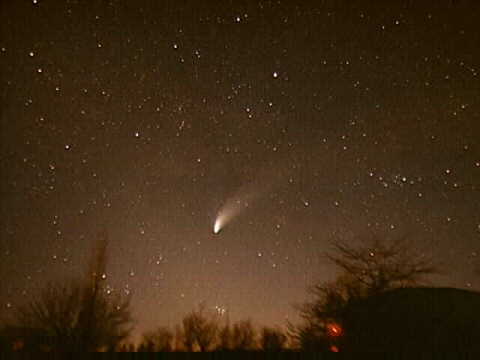 Caption: Comet Hale-Bopp in zodiacal light near
the end of twilight. 2 minutes 28mm f/4 on ISO
400 SFW film. This image is reproduced at 75% the
size of the other pictures.
Caption: Comet Hale-Bopp in zodiacal light near
the end of twilight. 2 minutes 28mm f/4 on ISO
400 SFW film. This image is reproduced at 75% the
size of the other pictures.
I took quite a few photos of the comet tonight
before moonrise, near the end of twilight. I'm
attempting to get a few shots before the moon
rises from the back yard. However my shrubs will
be getting in the way in a week or so. Amazingly
the comet, though noticeably dimmer than the last
time I've seen it in dark skies, has about the
same length tail.
- April 14, 1997
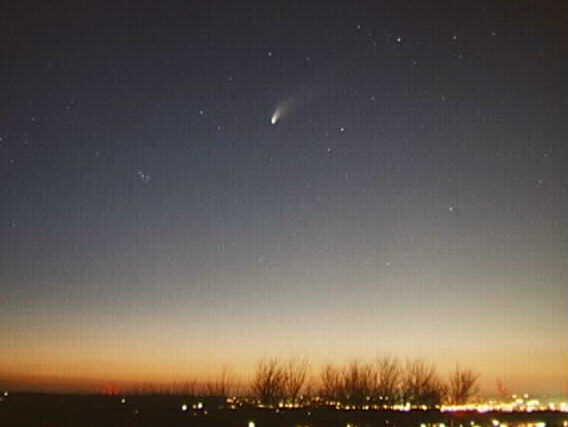 Caption: Comet Hale-Bopp in the
fading twilight. 20 seconds 28mm f/4 on ISO 200
SFW film.
Caption: Comet Hale-Bopp in the
fading twilight. 20 seconds 28mm f/4 on ISO 200
SFW film.
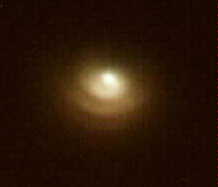 Caption: Internal structure of Comet
Hale-Bopp. 10 seconds C-14 Eyepiece projection
f/40 on ISO 400 SFW film.
Caption: Internal structure of Comet
Hale-Bopp. 10 seconds C-14 Eyepiece projection
f/40 on ISO 400 SFW film.
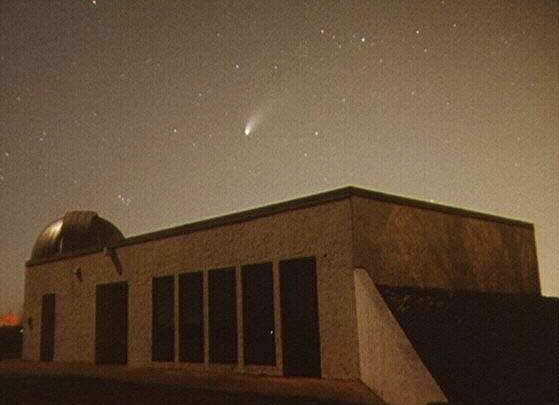 Caption: Comet Hale-Bopp over the Rogers
Observatory. 20 seconds 28mm f/4 on ISO 200 SFW
film.
Caption: Comet Hale-Bopp over the Rogers
Observatory. 20 seconds 28mm f/4 on ISO 200 SFW
film.
A second clear night in a row. The moonlight was
interfering with getting a long exposure of the
comet for the maximum tail. I had received the
actual negatives for the photographs of March
31st, and April 1st. All the negatives through
the Rogers Observatory's C-14 did show the
concentric arcs. I will have to find someone to
bring those out on a print. I took more C-14
photographs at prime focus and eyepiece
projection. I also took more
"glamour" shots of the comet,
moonlit observatory dome, and the lights of
Traverse City.
- April 13, 1997
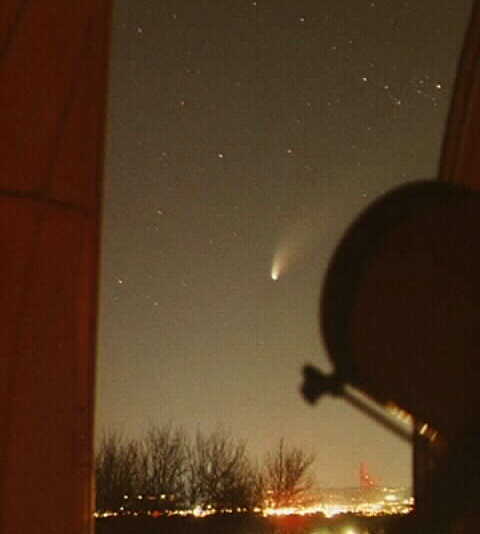 Caption: Comet Hale-Bopp
through the Roger's Observatory shutter. 40
seconds 50mm f/4 on ISO 200 SFW film.
Caption: Comet Hale-Bopp
through the Roger's Observatory shutter. 40
seconds 50mm f/4 on ISO 200 SFW film.
Finally on the last night of the add-on weekend
of public comet watches we get clear skies. We
got about 150 visitors to the Rogers observatory.
I took some eyepiece projection photographs with
the C-14 of the head of the comet. I had
downloaded the photos of March 31st and found
that even the shortest photograph with the C-14
had the nuclear area overexposed, not showing the
interior structure of those concentric shells, or
whatever in the head of Hale-Bopp. I also took
some shots of the comet and the observatory dome
in the moonlight.
- April 9, 1997
- A fortuitous break in the clouds. First break
in 6 days allowed about 35 Benzie Central 8th
graders to view the comet from the Rogers
observatory. Due to the commitment I didn't have
a long time to study the comet itself. I took no
photographs. It comet didn't look much if at all
diminished from the third.
- April 3, 1997
- Today was a beautiful clear day. I went back
to the spot behind the house where the lights
from the road won't interfere. I took some shots
of the comet above a tree in twilight. The comet
was the same brightness and tail length as
before. I was able to take some nice 28mm wide
angle shots. I took one of the area from the
comet to the Hyades in Taurus. This time the film
was Fujichrome 400 and had the film processed the
next day. I was able to get a good image of the
comet and zodiacal light.
These images won't be scanned very soon if at
all. It means that the similar shot on the 1st
that will be scanned might be OK.
- April 1, 1997
- Another clear day, but as the sun set there
were high clouds along the western horizon. As
the warmer weather has melted the snow, now only
snow drifts remain. I got a chance to move the
camera mount behind the house away from the
lights of the road, and hiding most of
"Antennae Borealis" behind shrubs. In
the darkness there the triangular zodiacal light
reached up to the Pleiades. I tried a wide angle
shot hoping to get the comet and the zodiacal
light in the same shot. I also spent an hour
taking various shots of the comet from 400 mm to
28 mm, from 20 to 300 seconds. Visually the
comet, on its perihelion day, showed two tails,
of about 10 and 13 degrees respectively for the
dust and ion tails. The famous Double Cluster
seems to be an extension of the ion tail.
 Questions? Comments? Email me at bob@bjmoler.org
Questions? Comments? Email me at bob@bjmoler.org
![]()
 This is my last observation of
the comet. The comet appears is a big break in
the clouds in the twilight. It is a beautiful
sight with the moon and the clouds. The exposure
was about 40 seconds on ISO 400 SFW film.
This is my last observation of
the comet. The comet appears is a big break in
the clouds in the twilight. It is a beautiful
sight with the moon and the clouds. The exposure
was about 40 seconds on ISO 400 SFW film.  Caption: Comet Hale-Bopp in zodiacal light near
the end of twilight. 2 minutes 28mm f/4 on ISO
400 SFW film. This image is reproduced at 75% the
size of the other pictures.
Caption: Comet Hale-Bopp in zodiacal light near
the end of twilight. 2 minutes 28mm f/4 on ISO
400 SFW film. This image is reproduced at 75% the
size of the other pictures.  Caption: Comet Hale-Bopp in the
fading twilight. 20 seconds 28mm f/4 on ISO 200
SFW film.
Caption: Comet Hale-Bopp in the
fading twilight. 20 seconds 28mm f/4 on ISO 200
SFW film.  Caption: Internal structure of Comet
Hale-Bopp. 10 seconds C-14 Eyepiece projection
f/40 on ISO 400 SFW film.
Caption: Internal structure of Comet
Hale-Bopp. 10 seconds C-14 Eyepiece projection
f/40 on ISO 400 SFW film.  Caption: Comet Hale-Bopp over the Rogers
Observatory. 20 seconds 28mm f/4 on ISO 200 SFW
film.
Caption: Comet Hale-Bopp over the Rogers
Observatory. 20 seconds 28mm f/4 on ISO 200 SFW
film.  Caption: Comet Hale-Bopp
through the Roger's Observatory shutter. 40
seconds 50mm f/4 on ISO 200 SFW film.
Caption: Comet Hale-Bopp
through the Roger's Observatory shutter. 40
seconds 50mm f/4 on ISO 200 SFW film.